Bexley Urban District Council Tramways
History
Bexley Council Tramways was a 5.1-mile, standard-gauge electric system that opened for business on the 3rd October 1903. It was slightly unusual in not actually serving the town in its title (Bexley), but rather Bexleyheath, which was a short distance to the north.
Although the newly opened system met the tracks of the Woolwich and South East London Tramways Company's horse tramway at its northwestern extremity, the two systems were not physically connected, the latter having been built to a gauge of 3ft 6ins. The council were, however, aware of the tramway aspirations of both Erith Urban District Council (to the northeast) and Dartford Urban District Council (to the southeast), so through traffic was always anticipated.
An end-on connection was made with Erith Council Tramways at Northumberland Heath on the opening of that system (26th August 1905), but not to Dartford Council Light Railways at Gravel Hill (opened on the 14th February 1906), where a few inches were left between the respective tracks. Given that Bexley's tramway was making a loss at this time, it seems perverse that the council refused to entertain through running by its two neighbours, a position that effectively forced passengers to get out and change trams at the municipal boundary. However, after coming under heavy criticism locally, Bexley eventually cut a deal with Dartford, with the latter's trams running through to Bexleyheath from the 27th August 1906.
Meanwhile, London County Council had acquired the W&SELTCo (in June 1905), which it subsequently converted to standard-gauge electric traction, opening the line from Woolwich through to Plumstead on the 17th April 1908. Unfortunately for the LCC, it needed to acquire a short length of Bexley-owned track for their Abbey Wood extension, so had to grant Bexley — no doubt through gritted teeth — running rights through to Woolwich. With this through-running agreement in the bag, Bexley now seemed receptive to more, so finally agreed to allow Erith cars to run through to Bexleyheath. This happy state of affairs was, however, not destine to last for long, with Bexley and Erith falling out over the rate to be paid for mileage run over Bexley's tracks; this resulted in termination of through running to Bexleyheath on the 25th July 1909. An attack of common sense eventually resolved matters, and through running began again on the 26th July 1910, though relations were to sour again four years later, resulting in cessation of through running on the 26th July 1914. It eventually took the Great War, and government intercession, to drive the two parties back to the table (munitions workers were being greatly inconvenienced), with through running returning at the end of October 1915.
Whilst passenger satisfaction and good neighbourliness do not seem to have featured highly on Bexley UDC's agenda, events were now to take a very different turn, and this time much to Bexley's credit. Neighbouring Dartford's tram depot, and its lessee's entire tramway fleet ,were destroyed by fire in the early morning of the 7th August 1917, with Bexley coming to the rescue in the form of emergency service provision from the 8th August, subsequently hiring in cars to provide a full service.
After the war, both systems suffered from the closure of munitions factories, and from the years of war-time neglect, increasingly incurring financial losses as time wore on. This eventually led to the formation of the 'Bexley Council Tramways and Dartford Light Railways Joint Committee', which was to run both systems as a single entity. The agreement was signed on the 6th February 1922, but back dated to the 1st April 1921, which was the day after the Dartford operating lease had expired. The official Dartford lessee was Balfour Beatty and Company, though they had in fact not operated the trams since the fire of 1917.
On the 1st July 1933, the systems of Bexley and Dartford passed, along with 12 others, into the hands of the newly formed London Passenger Transport Board. The last tram over Bexley metals, operated by the LPTB, ran on the 23rd November 1935.
Uniforms
The precise chronology of the uniforms issued by Bexley Council Tramways is a little unclear. Although the majority of Edwardian photographs show tramcar crews wearing single-breasted jackets, the occasional image shows them wearing double-breasted lancer-style tunics. On the basis of the available evidence, it seems likely that both motormen and conductors were initially issued with single-breasted jackets, with motormen at some point (probably in the mid-to-late Edwardian era), being switched to double-breasted, lancer-style tunics. The single-breasted jackets bore five buttons (containing a stylised letter 'B' — see link), two breast pockets (with button closures), epaulettes (again with button closures) and stand-up collars; both the epaulettes and the right-hand collar bore badges of some description, possibly employee numbers, though these cannot be made out with certainty on surviving photographs. These uniforms are believed to have been of dark, navy-blue serge. The caps were of the tensioned-crown type with a glossy peak; they bore 'off the shelf', script-lettering grade badges, either 'Motorman' or 'Conductor'. A small badge was worn above the grade badge, comprising the white horse of Kent above a scroll containing the Kent motto, 'INVICTA'.
Whilst there is some anecdotal evidence suggesting that the buttons and insignia were brass, it would be unwise to put too much credence in this.
The lancer-style tunics issued to motormen bore five pairs of buttons (narrowing from top to bottom), epaulettes and stand-up collars; the tunics were apparently in blue serge with red piping and appear to have been worn right through to the takeover of the system by the London Passenger Transport Board in 1933. In contrast, conductors single-breasted jackets were eventually updated to a more modern cut with five buttons, epaulettes and lapels, probably in the mid-1920s.
Tramcar crews were also provided with double-breasted greatcoats that bore five pairs of buttons, epaulettes and high fold-over collars; the epaulettes carried an employee number and a small badge, almost certainly the same pattern as worn on the cap, whilst the collars were devoid of insignia.
Motormen and conductors always appeared in service wearing enamel Public Carriage Office licence badges, which were issued by the Metropolitan Police (see link).
Whilst it is believed that inspectors initially wore elaborate bandmaster-style uniforms with black braid frogs, photographic evidence that would confirm this remains elusive. By the time of the Great War, and probably from much earlier, inspectors were wearing double-breasted jackets bearing four pairs of buttons with lapels; the jacket collars carried the grade — 'Inspector' — in embroidered script lettering. The tensioned-crown peaked caps bore the grade, almost certainly embroidered, on a hat bad.
In common with the vast majority of UK tramways, Bexley employed women during the Great War to replace male staff lost to the armed services. These ladies were issued with smart tailored uniforms comprising single-breasted jackets with five buttons (offset to one side), two waist pockets (with button closures), a belt with button fastening, cuffs with button adornment and high fold-over collars; the latter were plain, i.e., devoid of insignia. A long matching shirt was also worn, which had a row of three buttons, aligned vertically, embellishing the bottom of the garment. Headgear comprised a felt bonnet with a wide brim, which carried a standard script-lettering grade badge affixed to a hat band. The ladies were also provided with long top coats with five pairs of buttons, epaulettes and high fold-over collars; the epaulettes carried a badge of unknown pattern, whilst the collars were devoid of insignia. The last conductresses ceased work on 24th December 1919.
Further reading
For a history of Bexley UDC Tramways, see 'The Tramways of Woolwich and South East London' by 'Southeastern'; Light Railway Transport League (1963).
Images
Motormen and conductors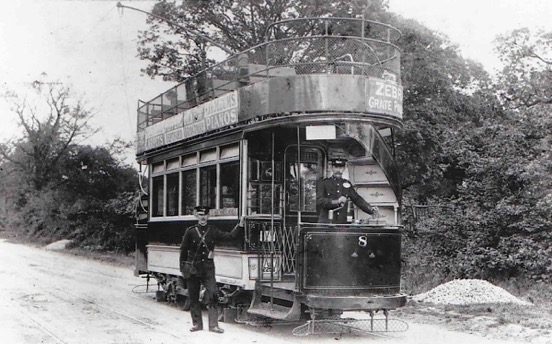
A conductor and a motorman stand with Tramcar No 8 at Courtleet Bottom — photo undated, but probably taken around 1903. Photo courtesy of the Tramways and Light Railway Society, with thanks to David Voice.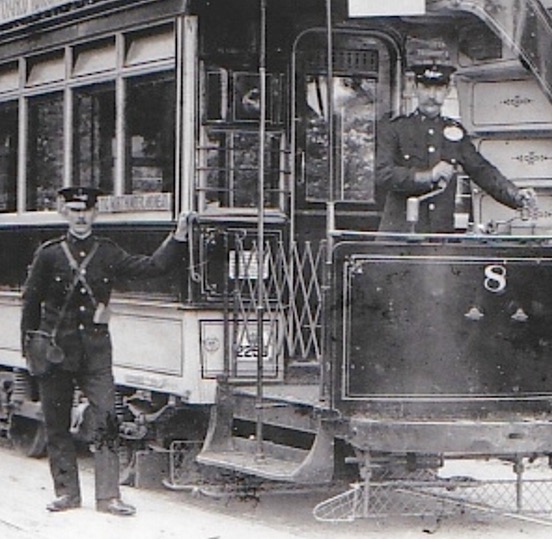
An enlargement of the above photograph showing the conductor and the motorman. Both men are wearing standard script-lettering grade badges on their caps, with a small badge above. 
Standard ‘off the shelf’ script-lettering cap badges of the type used by Bexley UDC Tramways — brass. Author's Collection.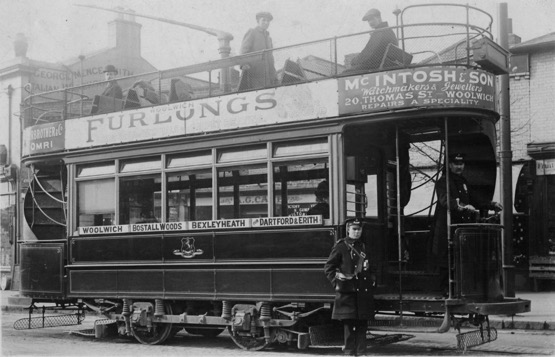
The crew of Tramcar No 13 stand with their vehicle at the Market Place in Bexleyheath, probably shortly before the Great War. The postcard was postally used in September 1913 so the image must pre-date this. Photo courtesy of the Richard Rosa Collection.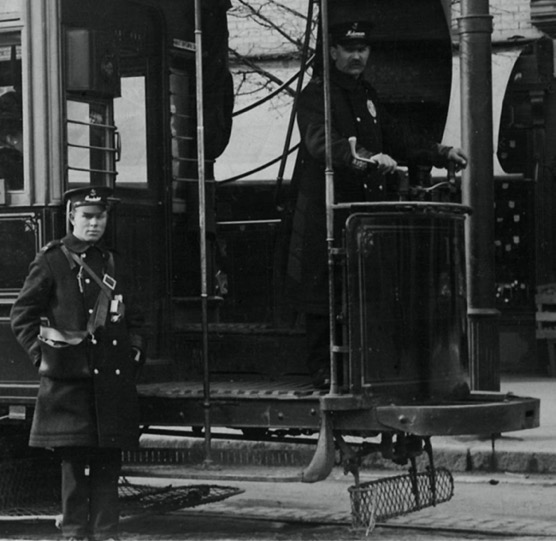
An enlargement of the above photograph showing the conductor and the motorman. Both men are wearing double-breasted greatcoats with high, fold-over collars and epaulettes. The latter bear an employee number and a municipal badge, the latter almost certainly the same type as worn on the caps; magnification reveals it have taken the form of the rampant white horse of Kent, with a scroll beneath (see later).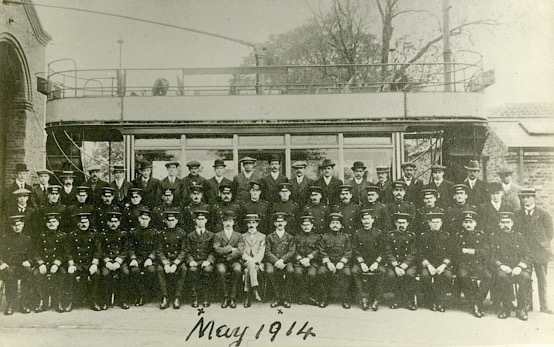
A staff photo taken at Gravel Hill depot in May 1914. Photo courtesy of Bexley Archives (see link).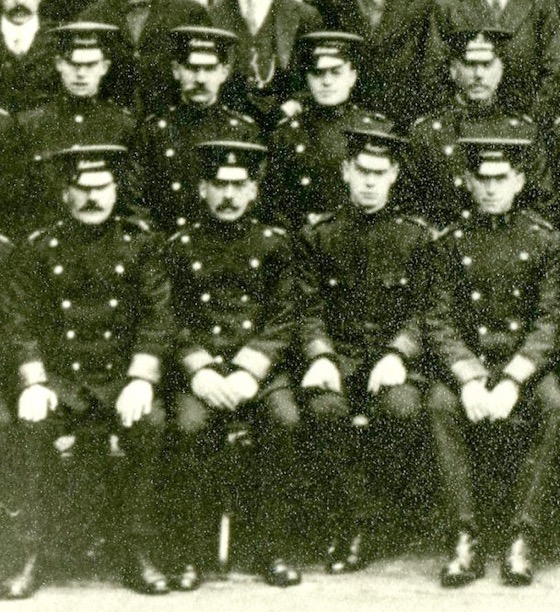
An enlargement of the above photograph showing eight of the motormen (in lancer-style tunics) and conductors (in single-breasted jackets). Only two of the individuals appear to be wearing a small badge above their script-lettering cap badges, suggesting that it was no longer being issued to new employees.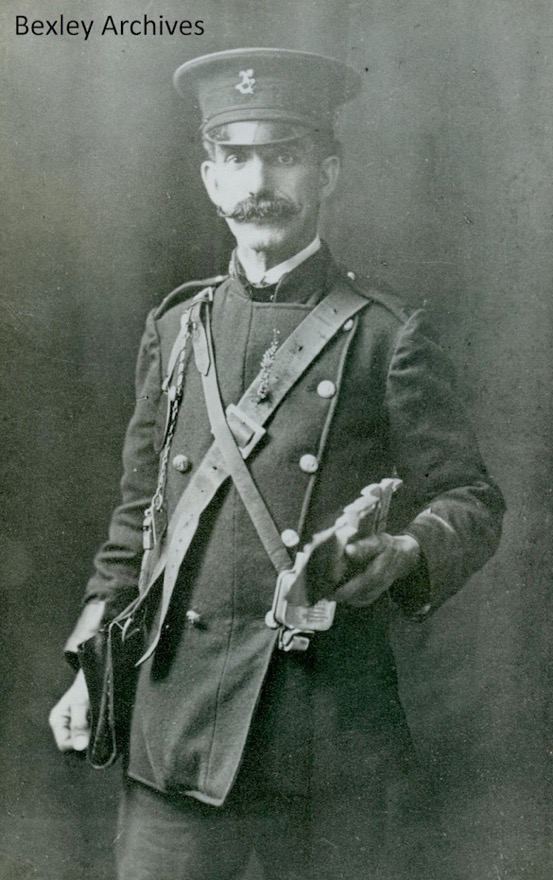
A Bexley Council Tramways Great War conductor. The buttons — on magnification — appear to bear a stylised 'B' within a garter. Photo courtesy of Bexley Archives (see link).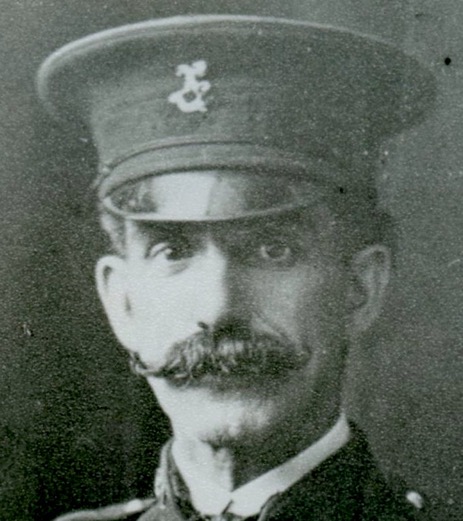
A blow-up of the above photo showing the cap badge, which comprises the white horse of Kent (rampant) above a scroll; the latter almost certainly bearing the Kent motto 'INVICTA'. 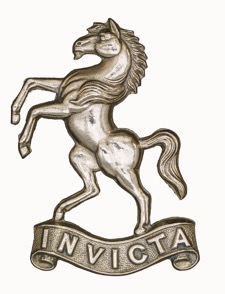
A rampant white horse of Kent badge, nickel. The precise pattern used by Bexley Council on tramway crew caps is unclear, however, it was almost certainly bought 'off the shelf', many Kent-based organisations, including several regiments in the British Army, using this type of badge. Although there is some anecdotal evidence to suggest that the Bexley buttons and insignia were brass, this is far from certain.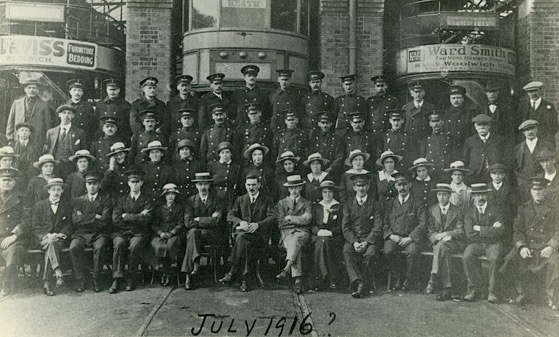
Another staff photo taken at Gravel Hill depot, purportedly in 1916, and presumably to record the new intake of female staff. Although wearing uniforms, the ladies appear to be in a variety of headgear, suggesting that a formal issue of hats had yet to arrive. Photo courtesy of Bexley Archives (see link).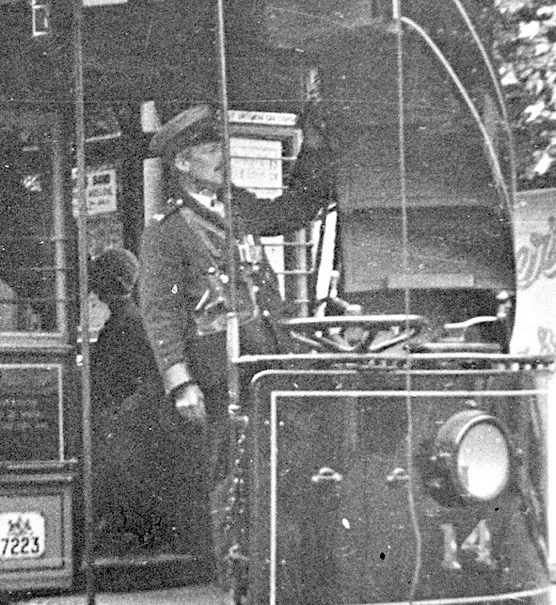
A Bexley Council Tramways conductor aboard Tramcar No 14 — photo undated, but probably taken in the early 1930s. Photo by Dr H Nicol, courtesy of the National Tramway Museum. 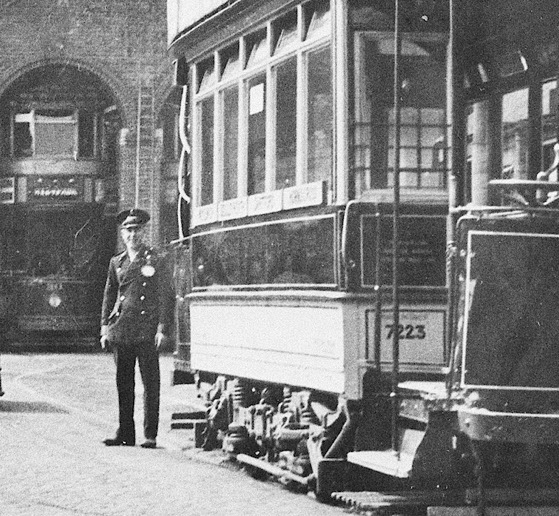
Another shot of Tramcar No 14, this time at the depot, with a motorman at the rear — photo taken in the 1930s by H Wightman, courtesy of the National Tramway Museum. 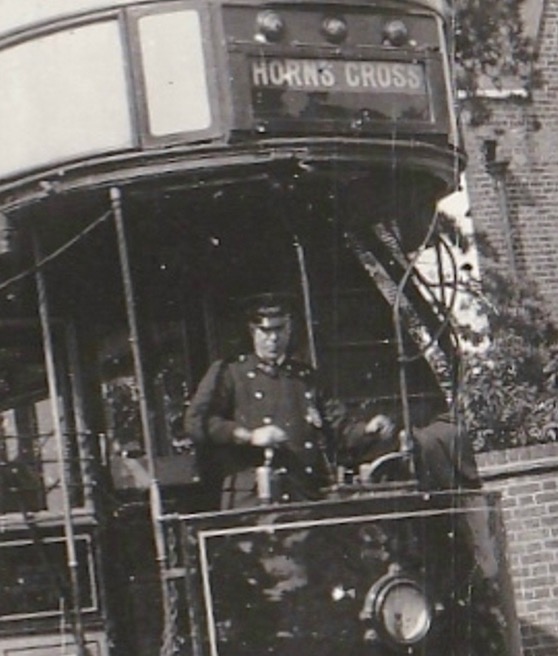
A motorman at the controls of Tramcar No 24 bound for Horns Cross — photo undated, but probably taken around 1930. Photo courtesy of the Tramways and Light Railway Society, with thanks to David Voice.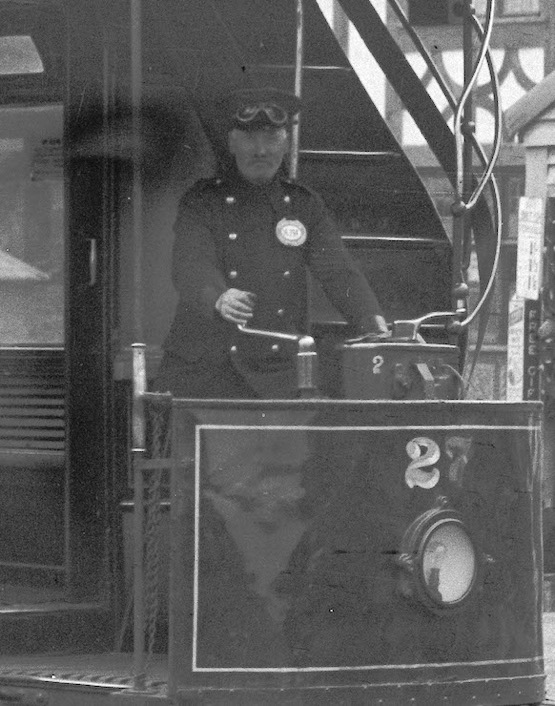
A Bexley Council Tramways motorman at the controls of Tramcar No 27 at Horns Cross on the 30th June 1933, the day before the LPTB takeover. His Public Carriage Office licence badge is suspended from one of the top pair of buttons of his lancer-style tunic. Photo by Dr H Nicol, courtesy of the National Tramway Museum.
Senior staff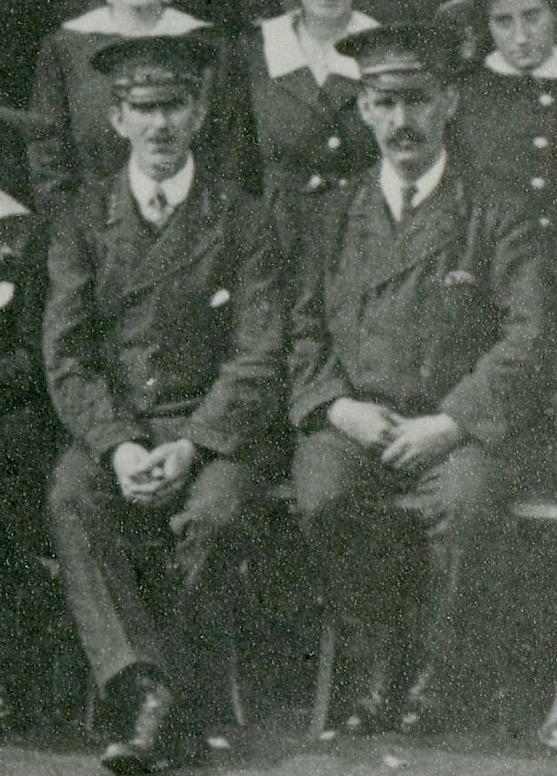
An enlargement of the 1916 staff photo above showing two of the inspectors.
Female staff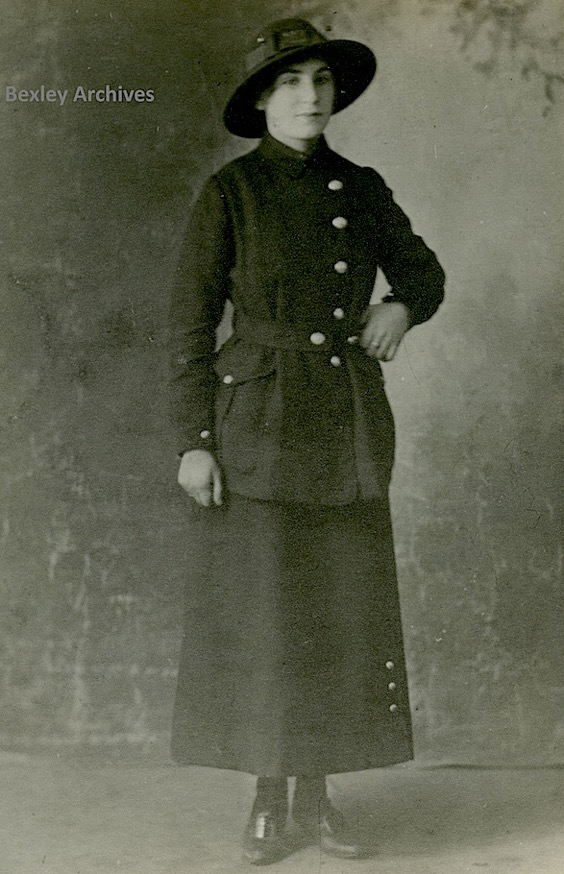
A slightly out-of-focus studio portrait of a Bexley Council Tramways Great War conductress, but one which does reveal the type of uniform worn — photo purportedly taken in 1918. The hat lacks the usual script-lettering grade badge, which is however present in other photos of female staff (not shown). Photo courtesy of Bexley Archives (see link).